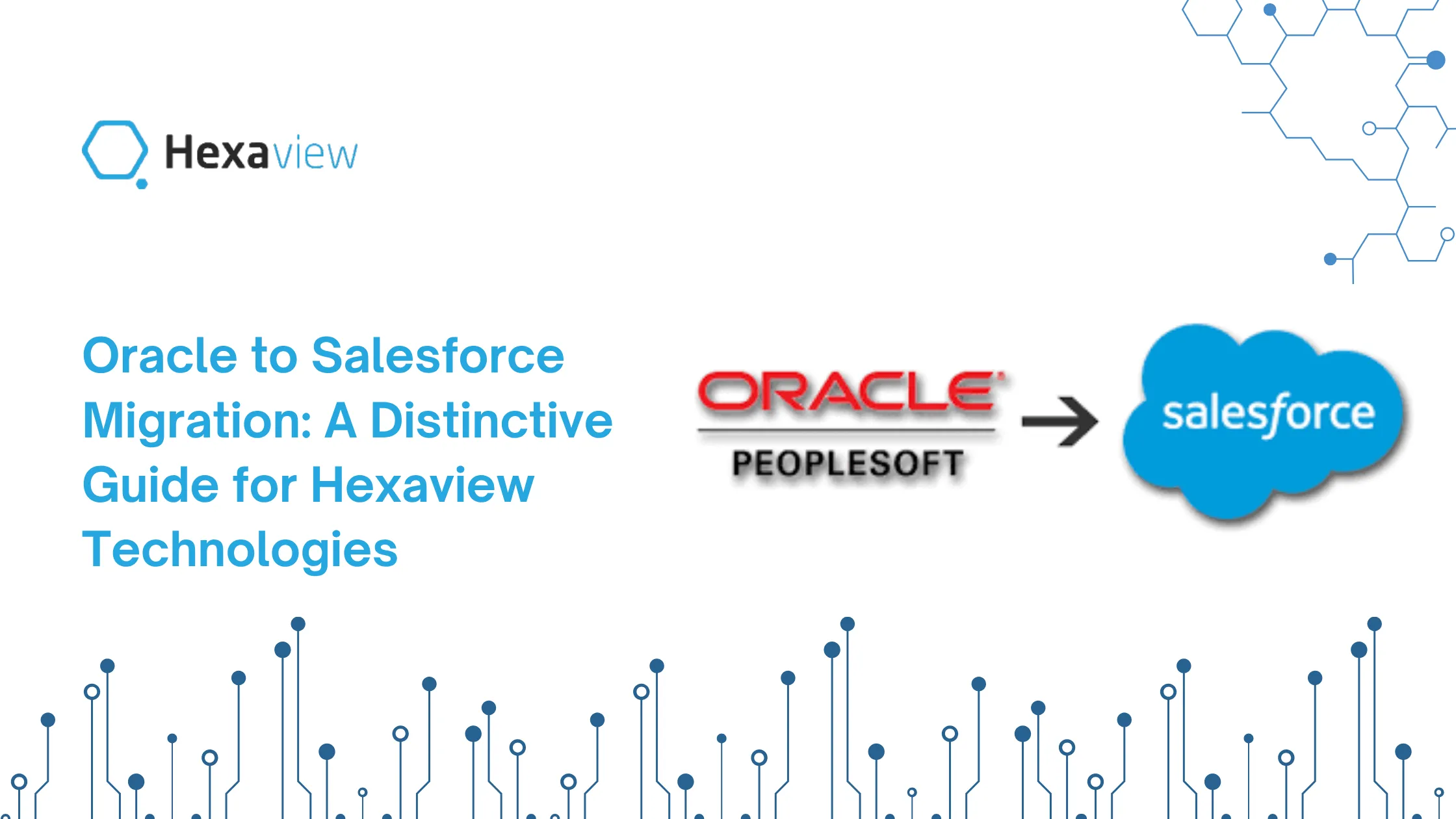Migrating from Oracle to Salesforce is a pivotal move for organizations determined to modernize their operations, boost efficiency, and stay ahead in a digital-first world. As a trusted partner in digital transformation, Hexaview Technologies brings deep expertise in Salesforce consulting, data migration, and custom development, ensuring a seamless and value-driven migration journey.
Transitioning from Oracle to Salesforce is more than a technical upgrade—it’s a strategic transformation that empowers organizations to innovate, scale, and thrive. Legacy systems like Oracle can become restrictive and costly over time, while Salesforce’s cloud-native platform offers flexibility, scalability, and a user-centric experience. This guide, tailored for Hexaview Technologies, outlines a comprehensive, actionable roadmap for a successful migration.
Why Transition from Oracle to Salesforce?
- Cloud-Driven Agility: Salesforce’s cloud-based architecture enables rapid adaptation to changing business needs.
- Enhanced User Experience: Intuitive interfaces and customizable dashboards drive higher productivity and adoption.
- Cost Efficiency: Lower maintenance and predictable subscription costs free up resources for innovation.
- Seamless Integration: Robust APIs and pre-built connectors simplify integration with existing tools.
- Advanced Analytics: Real-time insights and AI-powered analytics support smarter decision-making.
- Scalability: Effortlessly scale your CRM as your business grows, without major infrastructure investments.
- Automatic Upgrades: Benefit from regular, seamless updates with no disruption to business operations.
Oracle vs. Salesforce: A Comparative Overview
FeatureOracle CRMSalesforce CRMDeploymentOn-premises or cloudCloud-native (SaaS)CustomizationCode-heavy, complexLow-code, user-friendlyIntegrationMay require middlewareExtensive APIs, AppExchangeUpgradesManual, can disruptAutomatic, seamlessUser InterfaceTraditional, less intuitiveModern, highly intuitiveAnalyticsAdvanced, may need add-onsBuilt-in AI, real-time dashboardsCost StructureLicensing + maintenanceSubscription-based, predictable
Hexaview’s Migration Methodology
With over a decade of experience and hundreds of successful projects, Hexaview Technologies offers a proven, phased approach to Oracle to Salesforce migration:
- Strategic Consulting: Assess readiness, define objectives, and create a tailored migration roadmap.
- Data Migration: Secure, accurate transfer of all business-critical data.
- Salesforce Customization: Adapt Salesforce to fit unique workflows and business logic.
- Integration Services: Connect Salesforce with other enterprise systems for unified operations.
- Managed Services: Provide ongoing support, optimization, and user training.
Detailed Oracle to Salesforce Migration Steps
1. Discovery & Planning
- Asset Inventory: Catalog all Oracle data sources, custom objects, and business processes.
- Scope Definition: Identify which data, workflows, and integrations will be migrated.
- Success Metrics: Set clear KPIs for data accuracy, system uptime, and user adoption.
- Risk Assessment: Develop strategies to mitigate data loss, downtime, and compliance risks.
- Stakeholder Engagement: Involve business leaders, IT teams, and end-users early to align expectations.
2. Data Extraction
- Data Export: Use Oracle tools or custom scripts to extract data in compatible formats (CSV, XML, JSON).
- Hierarchy Preservation: Maintain parent-child relationships for accurate mapping in Salesforce.
- Comprehensive Backup: Securely back up all data before migration.
3. Data Transformation & Mapping
- Data Cleansing: Eliminate duplicates, obsolete records, and standardize formats.
- Field Mapping: Align Oracle fields to Salesforce objects, considering data types and validation rules.
- Logic Reengineering: Convert Oracle triggers and stored procedures into Salesforce workflows or Apex code.
- Data Enrichment: Enhance data with additional attributes or external sources if needed.
4. Data Loading
- Salesforce Configuration: Set up custom fields, validation rules, and user permissions.
- Batch Import: Use Salesforce Data Loader or Bulk API for efficient, error-monitored imports.
- Progress Monitoring: Track batch jobs and resolve any import errors promptly.
- Incremental Loads: For large migrations, use incremental data loads to minimize downtime.
5. Validation & Testing
- Integrity Checks: Run reports to verify data completeness and accuracy.
- User Acceptance Testing: Engage end-users to validate workflows and data usability.
- Performance Testing: Ensure the new Salesforce environment meets business requirements.
- Iterate: Refine mappings and processes based on feedback.
6. Training & Go-Live
- Role-Based Training: Develop tailored training materials for different user groups.
- Support Resources: Provide helpdesk support and documentation for post-migration queries.
- Adoption Monitoring: Use Salesforce analytics to track user engagement and address gaps.
- Go-Live Planning: Schedule the final cutover during low-traffic periods and ensure rollback plans are in place.
7. Post-Migration Optimization
- Continuous Improvement: Gather feedback and implement enhancements to maximize ROI.
- Ongoing Support: Allocate resources for troubleshooting and system maintenance.
- Leverage New Features: Take advantage of Salesforce’s latest innovations and integrations.
Best Practices for a Smooth Migration
- Prioritize Data Quality: Cleanse and validate data at every stage.
- Document Everything: Keep detailed records of mappings, transformations, and decisions.
- Test Thoroughly: Use Salesforce sandboxes for iterative testing before production rollout.
- Engage Stakeholders: Involve business and technical teams early and often.
- Plan for Support: Allocate resources for troubleshooting and user support post-migration.
- Automate Where Possible: Use automation tools for data extraction, transformation, and loading.
- Monitor and Audit: Implement monitoring to track data integrity and system performance.
Common Challenges and Solutions
- Complex Data Structures: Invest in thorough data analysis and mapping to prevent surprises.
- Inadequate Testing: Conduct comprehensive testing and involve end-users in validation.
- Change Management: Prioritize user training and communication to drive adoption.
- Security Concerns: Ensure data is encrypted during transfer and configure Salesforce security settings.
- Rushed Timelines: Opt for phased, incremental migrations to reduce risk.
Case Study: Real-World Impact
A leading financial services client partnered with Hexaview for an Oracle to Salesforce migration. The project achieved:
- 30% reduction in order processing time
- Improved data accuracy and reporting
- Higher user satisfaction and adoption rates
- Significant cost savings on IT maintenance
Project Highlights:
- Comprehensive data analysis and mapping
- Custom Salesforce configuration to match business workflows
- Phased data migration for risk mitigation
- Targeted user training and ongoing support
Post-Migration Benefits
- Faster Information Access: Real-time data boosts productivity and customer service.
- Self-Service Capabilities: Empower users with customizable dashboards and portals.
- Customization and Control: Tailor reviews, approvals, and workflows to business needs.
- Scalability: Adapt to future requirements without major infrastructure changes.
- Enhanced Security: Benefit from robust security features and compliance tools.
- Innovation Enablement: Leverage Salesforce’s ecosystem for continuous improvement.
Why Hexaview Stands Out
- Proven Track Record: 14+ years in operation, 300+ projects delivered, and a 90% client retention rate.
- Domain Expertise: Deep experience across financial services, healthcare, IT, and more.
- Agile Delivery: Flexible, client-centric approach ensures rapid, high-quality results.
- Cutting-Edge Technology: Solutions built on AI, ML, Big Data, and Blockchain.
- End-to-End Partnership: From assessment to post-migration support, Hexaview is with you every step.
Conclusion
A successful Oracle to Salesforce migration is a journey that demands careful planning, expert execution, and a focus on data quality and user experience. By following a structured, best-practice-driven approach, organizations can unlock the full potential of Salesforce, drive business growth, and future-proof their CRM strategy.
Ready to transform your business? Connect with Hexaview Technologies for a tailored Oracle to Salesforce migration strategy that delivers measurable results.



%201.svg)
